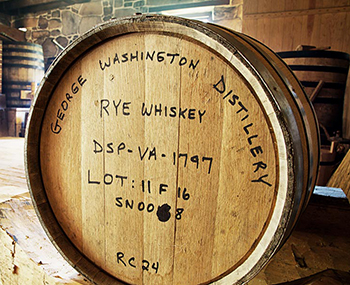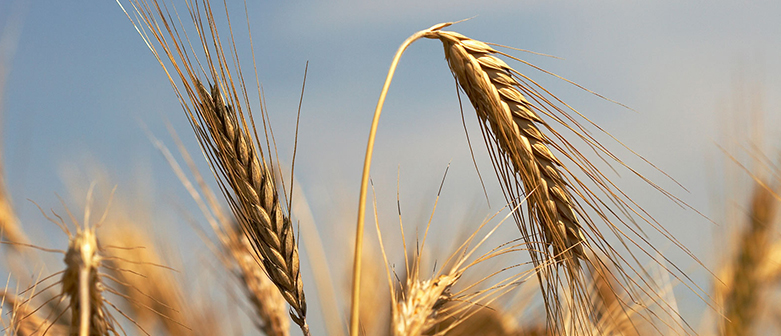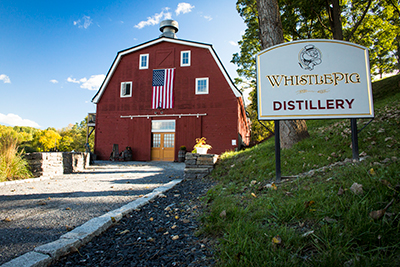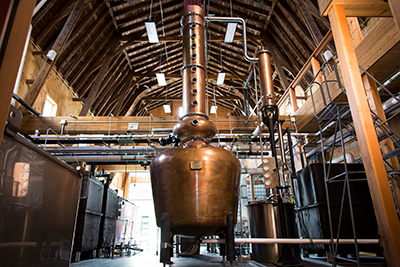Rye whiskey has had a fascinating history and an unexpected resurgence.
When WhistlePig launched their ‘No History, No Rules’ cocktail competition with three trips to Vermont up for grabs (entries are still open get yourself involved if you haven’t already), we realised our Rye Whiskey knowledge is not as good as it should be. Seeing as we were going to be travelling the country judging the competition we thought we should gen up on one of our favourite spirits categories to drink.
We discovered a rollercoaster story with George Washington, prohibition and even Hollywood playing the villains, with Canada and bartenders your plucky hero’s. So we will have a look back and then a look at why WhistlePig epitomise the future.
Flying Rye
When America was invaded and colonised by Europeans, they didn’t waste any time getting themselves distilling. Back then a still was considered just another piece of farming equipment and a very efficient way of making money from the land. As they mainly began to settle around what is now New York they discovered that it was rye, a favourite of Germanic settlers (hinting that they were as important as the Irish and Scots in early US distilling), which suited the climate and soil best where native corn flourished a little further south.
Soon two distinct styles of rye whiskey emerged based on the states which produced them. Pennsylvanian Rye, also known as Monongahela Rye after the states famous river, was more like modern day rye made with either 100% rye or 80+% with the rest made up of barley malt. Maryland Rye was, due to the states slightly more southern positioning, generally a mixture of rye (usually around 65%) and corn, making it a sweeter proposition.
In the latter half of the 1700’s rye got a real shot in the arm when some blokes in Boston threw some tea over the side of a boat. We’re not going to get into the politics of the Boston Tea Party here but what it did do is start an anti-British movement in the country which culminated in the American Revolution. The Brits were bringing in rum to American shores which was hugely popular at the time but this was quickly swapped for rye by vast numbers of the country.
By the time the American Revolution ended in 1791 there were thousands of distilleries in both Pennsylvania and Maryland (as well as New York and Virginia) knocking out loads of rye whiskey. It had all been positive stuff for rye, but the first nail in its coffin was going to come from an unexpected source.
George of the Bungle
George Washington is famous for making whiskey (oh and being the first US president blah blah blah), a fact that I assumed meant he made a few bottles for him and his mates to drink at a BBQ and it was probably bourbon. In actual fact between 1797 to 1799 he ran a distillery which sold, in 1799 alone, 11,000 gallons of rye whiskey making it one of the biggest distilleries in the country.
What a dude. Am I right? No, I’m very much not right.
Rewind back to 1791, when it was all going so well, and old ivory chompers Washington (his teeth weren’t wooden apparently), on advice of that Hamilton bloke who invented rapping, introduced a tax on spirits distilled in the US, which had devastating effects on small farms. This didn’t go down well leading to a Whiskey Rebellion in 1794 which Washington led a 12,000 strong militia against to, successfully, break up. Once all the small producers went bust he built his distillery and cleaned up. See, not a dude.
As a side note a lot of the small distillers in Pennsylvania disenfranchised by this whole affair upped sticks and moved to Kentucky where the whiskey tax was not being enforced. The previously mentioned Monongahela River turns into the Ohio River so they travelled down the river until they reached the Ohio Falls and could go no further. This area was called Louisville, where corn grew aplenty, so they changed to making a Maryland style of rye and eventually bourbon. How’s that for a knowledge bomb?
Despite the taxation, rye production and consumption continued to grow at a rapid rate and cemented itself as the nation’s favourite. By the time the first cocktail revolution came at the end of the 1800’s it was no surprise to see rye being front and centre of the most popular drinks of the time, the Old Fashioned, Manhattan and Sazerac. It seemed there was no stopping it.
1933 Is Overrated
It is often considered that 1933 was a great year in the US, it saw the end of prohibition after all, but it was where it all started to go wrong for the world of rye. Yes, prohibition was of course a nightmare for the rye industry, but bourbon bounced back stronger whereas rye fell away. Why?
It is known that during prohibition Americans were the sickest they have ever been, well they claimed to be the sickest at least to get hold of the medicinal whiskey doctors were prescribing. As a result of all this medicinal whiskey being subscribed the aged whiskey stockpiles went down massively during prohibition, this was a widely known fact and yet the government didn’t give the distillers a chance to produce any in the lead up to the end of prohibition to solve the problem.
To make matter worse the six distilleries that were allowed to stay open during prohibition to make medicinal whiskey were all in Kentucky, ensuring they were much better suited to bounce back.
There were ships full of scotch whisky and rum waiting off the shores of the country to flood the market when prohibition ended but also Canadian Whiskey ready to cross the border. The Canadian Whiskey was predominantly rye whiskey, unfortunately a majority of it wasn’t great quality (they undoubtably kept the good stuff for themselves) which began to undermine all the good work American Rye producers had done.
It was all looking bad for rye, and then it got a whole lot worse. To aid the countries recovery from the Great Depression the government introduced the Agricultural Adjustment Act of 1933, the only problem was it supported corn and not rye (rye was added some years later, by which time the damage had been done). This meant that the making of bourbon got much cheaper and whilst due to the lack of aged whiskey stocks quality was not at its highest bourbon distillers could compete against spirits from abroad on price whilst they waited for aging stocks to recover (a bit like the modern trend of new distilleries producing a gin whilst aging new product), a luxury rye producers did not have
Any chance of a late recovery was smashed by Hollywood. By the 1940’s rye was exclusively seen onscreen being consumed by drunks and layabouts and portrayed as cheap, poor quality booze. The dramatic collapse was complete, in less than 25 years the rye market had been decimated.
Here Comes The Bartender
As we know there was the vodka revolution, followed by the gin boom but in early 2000’s a trend emerged that the experts didn’t see coming. Bartenders began to look away from blue party drinks and at the history of their craft. Suddenly classic cocktail books by the likes of Jerry Thomas and Harry Craddock were being studied by bartenders, and the classic drinks contained within their pages were being revisited.
Unsurprisingly now we know the history of Rye Whiskey it featured heavily in the recipes but there wasn’t the variety or quality of whiskies available in the industry to support the boom. In 2006 the rye category grew by 20% and by 30% in 2007. In a 2020 interview with People.com Jimmy and Eddie Russell of Wild Turkey fame spoke about the boom with Eddie admitting, ‘I used to make rye two days a year, make bourbon 250 days. Now I make rye two days a month.’
As this quote shows the larger whiskey producers in the US just weren’t prepared for the boom and were also, and importantly, busy making a whole load of bourbon. Who was going to fill this rapidly expanding gap in the market? Thankfully there were a few people in the industry who did foresee this need and were busy setting themselves up to become the bartenders new best friends.
One of these pioneers was a legend in the American Whiskey world, Master Distiller Dave Pickerell. In the early 2000’s he could see the demand on the horizon, but his employers were, understandably, busy concentrating on a rather successful brand. Luckily for, well everyone, Dave found some fellow rye enthusiasts to team up with to produce ‘the best rye whiskey on, and for, the planet’.
Someone once said ‘Making whiskey is easy. All you need is grain, water, tools, barrels, a facility and time.’. As they set out to create their dream, they quickly realised they had access to none of these. Their biggest problem was time. They knew that the money they had put aside for the project would not last very long. In other words, building a distillery from scratch and ageing a whiskey for 10 or more years to get the results they wanted was not going to be possible given the resources.
So they launched a gin. Only kidding. Thankfully they didn’t go down that line. Instead they found the answer to their dilemma somewhere already well linked to the history of rye.
Dave set about travelling across the US to find some aged rye they could use whilst their own product was being produced and aged. Unfortunately, everything we know about the history of rye quickly made it apparent the stocks available were either poor quality or in small amounts. Canada was a different beast entirely. No prohibition and a climate perfect for growing rye (and as we have pointed out they kept the good stuff for themselves) meant that Dave quickly found a 10 year old rye that was unlike anything that he had tasted before and was exactly what he was hoping to find. It was being used, criminally, in a cheap blend but that was about to end, the decision to buy the lot was made on the spot.
Learn From Your Mistakes
Right from the start WhistlePig was not going to follow the traditions, experimentation was always key to the brand. As Chief Blender, Meghan Ireland once put it ‘I will put whiskey in any kind of barrel once.’
It was this ability to look beyond tradition and the norm that in 2007 led WhistlePig to find their home in Vermont in the heart of the rye growing heartland. and It was also close to the border of Canada where their whiskey was transported from, before being finished and blended on site. The site is an old dairy farm in the middle of a 500-acre paradise of fields, maple and oak trees, fresh well water and views over the Green Mountains.
In our opinion one of the most interesting things about WhistlePig and therefore of the competition prize of a trip to the distillery (which isn’t open to the public) is their embracing of mistakes. If you are going to experiment, and push/ignore the boundaries of whiskey making, often tied to history, then some of these experiments are going to be failures. Whilst most would shy away from this WhistlePig embrace and drink them. The three winners will, as a result, be able to drink whiskey that only a small handful of people have and will ever try.
One area of experimentation came in the form of casks for ageing. They not only scoured the globe to find the most unique and exciting casks available but also made some using oak from their own farm. Some failed and some added nothing, but some of the experiments led to great things such as the now famous WhistlePig Boss Hog.
The parallels between WhistlePig and modern bartending is there for all to see. Not only do they provide the industry with the products they want and need, but they think about creation of whiskey the same way bartenders think about the creation of cocktails.
Meghan put it best when she said ‘We are always allowed to ask questions. I do not think I was ever told I could not experiment.’ and it was this that led to the concept for the cocktail competition. WhistlePig want you to ignore the confines put onto you by history. Want you to let yourself think unencumbered by how rye has traditionally been used.
WhistlePig Brand Ambassador Dan Priseman explains, ‘We don’t want people to think the drink automatically has to be stirred down because it’s a rye cocktail. If you have ever wondered what rye and Hubba Bubba tastes like, this is your chance to find out. Never heard of a rye and pink grapefruit liqueur cocktail? Why not? If anyone has ever told you ‘you can’t do that’ this is your chance to try it.’
The competition is still open for entries until midnight on 15th May so get yourself involved and win a trip to Vermont here.




